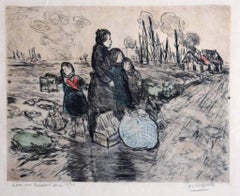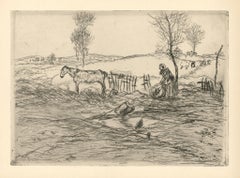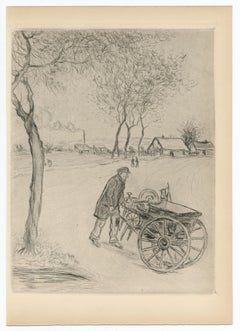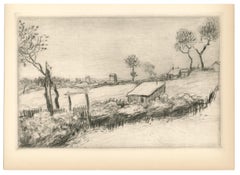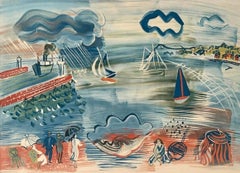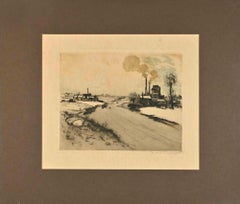Jean-Francois Raffaelli Art
to
7
5
7
7
5
5
5
2
2
1
Le Petit Oiseau - Etching by Jean François Raffaelli - 1915
By Jean-Francois Raffaelli
Located in Roma, IT
Hand signed. Not numbered. With dedication to "Bernard" (1921).
Etching and aquatint technique. Perfect conditions.
Image Dimensions : 15 x 19 cm
Passepartout included : 35 x 50 cm
Category
1910s Post-Impressionist Jean-Francois Raffaelli Art
Materials
Etching
"La terrain perdu" original etching
By Jean-Francois Raffaelli
Located in Henderson, NV
Medium: original etching and drypoint. Catalogue reference: Delteil 16. Printed in 1909 and published in Paris by Henri Floury. Plate size: 5 1/2 x 7 3/4 inches (142 x 197mm). Not si...
Category
Early 1900s Jean-Francois Raffaelli Art
Materials
Etching
"Le Remouleur" original etching
By Jean-Francois Raffaelli
Located in Henderson, NV
Medium: original etching and drypoint. Catalogue reference: Delteil 76. Printed in 1909 and published in Paris by H. Floury. Plate size: 8 3/8 x 6 1/2 inches (212 x 165 mm). Not sign...
Category
Early 1900s Jean-Francois Raffaelli Art
Materials
Etching
"Sous la pluie" original etching
By Jean-Francois Raffaelli
Located in Henderson, NV
Medium: original etching and drypoint. Catalogue reference: Delteil 86. This lovely drypoint was executed by Raffaelli in 1909 and published in Paris by H. Floury. Plate size: 3 1/4 ...
Category
Early 1900s Jean-Francois Raffaelli Art
Materials
Etching
Landscape - Etching by J. F. Raffaelli - Late 19th Century
By Jean-Francois Raffaelli
Located in Roma, IT
Etching and drypoint. Hand signed.
Very good condition.
Category
Late 19th Century Modern Jean-Francois Raffaelli Art
Materials
Etching, Drypoint
"La Neige (soleil couchant)" original etching
By Jean-Francois Raffaelli
Located in Henderson, NV
Medium: original etching and drypoint. Catalogue reference: Delteil 86. This impression on wove paper was printed in 1909 and published in Paris by Henri Floury. Plate size: 5 3/4 x ...
Category
Early 1900s Jean-Francois Raffaelli Art
Materials
Etching
"Le Marchand de Habits" original etching
By Jean-Francois Raffaelli
Located in Henderson, NV
Medium: original etching and drypoint. Executed in 1895; catalogue reference Delteil 24. This impression on laid paper was printed in 1895 for Gustave Geffroy's "La Vie Artistique". ...
Category
1890s Jean-Francois Raffaelli Art
Materials
Etching
"La Neige (soleil couchant)" original etching
By Jean-Francois Raffaelli
Located in Henderson, NV
Medium: original etching and drypoint. Printed in 1909 and published in Paris by Henri Floury. Plate size: 8 1/4 x 5 5/8 inches (212 x 143 mm). Not signed.
Category
Early 1900s Jean-Francois Raffaelli Art
Materials
Etching
Programme for the Theatre - Lithograph by J. F. Raffaelli - 1889
By Jean-Francois Raffaelli
Located in Roma, IT
Programme for the Theatre is a Lithograph realized by Jean François Raffaelli (1850-1924).
Good condition on a yellowed paper included a white cardboard passpartout (35x51 cm).
Hand signed by the artist on the lower margin.
Jean-François Raffaëlli (April 20, 1850 – February 11...
Category
Late 19th Century Art Nouveau Jean-Francois Raffaelli Art
Materials
Lithograph
L'embarquement de boeufs - Impressionist Oil, Cattle by Jean Francois Raffaelli
By Jean-Francois Raffaelli
Located in Marlow, Buckinghamshire
Wonderful signed oil on panel cattle and figures in landscape by French impressionist painter Jean-Francois Raffaelli. The work depicts oxen being loaded onto ships in Honfleur, France en route to England.
Signature:
Signed lower right
Dimensions:
Framed: 18"x16"
Unframed: 9"x8"
Provenance:
Exhibition Jean Francois Raffaélli held at Galerie Simonson, 19 Rue Caumartin Paris - October 1929 (number 44)
Jean-François Raffaëlli's father was a failed Italian businessman and Raffaëlli himself was, among other things, a church chorister, actor and theatre singer. He then studied under Gérôme at the École des Beaux-Arts in Paris. He travelled to Italy, Spain and Algeria and on his return to France settled in Asnières.
In 1876, on a trip to Brittany, he first saw the potential of realist subject matter, if treated seriously. He became involved in meetings of artists at the Café Guerbois, where the Impressionist painters used to gather. As a result, Degas, contrary to the advice of the group, introduced Raffaëlli to the Impressionist exhibitions - according to one uncertain source as early as the very first exhibition, at the home of Nadar, and certainly to those of 1880 and 1881.
In 1904, Raffaëlli founded the Society for Original Colour Engraving. He first exhibited at the Salon de Paris in 1870 and continued to exhibit there until he joined the Salon des Artistes Français in 1881, where he earned a commendation in 1885, was made Chevalier of the Légion d'Honneur in 1889 and in the same year was awarded a gold medal at the Exposition Universelle. In 1906 he was made Officier of the Légion d'Honneur. He was also a member of the Société Nationale des Beaux-Arts. In 1884, a private exhibition of his work cemented his reputation.
He contributed to several newspapers such as The Black Cat (Le Chat Noir) in 1885 and The French Mail (Le Courrier Français) in 1886 and 1887. He published a collection entitled Parisian Characters, which captured his favourite themes of the street, the neighbourhood and local people going about their lives. In 1880 he participated, with Forain, on the illustration of Joris Karl Huysmans' Parisian Sketches (Croquis Parisiens). He also illustrated Huysman's Works. As well as working as an illustrator, he also made etchings and coloured dry-points.
His early attempts at painting were genre scenes, but once he was settled in Asnières he started to paint picturesque views of Parisian suburbs. From 1879 onwards, his subject matter drew on the lives of local people. These popular themes, which he treated with humanity and a social conscience, brought him to the attention of the social realist writers of the time such as Émile Zola. In addition to his realist style, Raffaëlli's dark palette, which ran contrary to the Impressionist aesthethic, helped to explain the opposition of those painters to his participation in their exhibitions. More concerned with drawing than colour, he used black and white for most of his paintings. Towards the end of his life, he lightened his palette, but without adopting any other principles of the Impressionist technique.
After painting several portraits, including Edmond de Goncourt and Georges Clémenceau, he returned to genre painting, particularly scenes of bourgeois life. Later in his career, he painted mainly Breton-inspired sailors and views of Venice. His views of the Paris slums and the fortifications, sites which have almost completely disappeared, went some way towards establishing a genre in themselves and perpetuated the memory of the area: The Slums, Rag-and-Bone Man, Vagabond, Sandpit, In St-Denis, Area of Fortifications. His realistic and witty portrayal of typical Parisian townscapes accounts for his enduring appeal.
Born in Paris, he was of Tuscan descent through his paternal grandparents. He showed an interest in music and theatre before becoming a painter in 1870. One of his landscape paintings was accepted for exhibition at the Salon in that same year. In October 1871 he began three months of study under Jean-Léon Gérôme at the École des Beaux-Arts in Paris; he had no other formal training.
Raffaëlli produced primarily costume pictures until 1876, when he began to depict the people of his time—particularly peasants, workers, and ragpickers seen in the suburbs of Paris—in a realistic style. His new work was championed by influential critics such as J.-K. Huysmans, as well as by Edgar Degas.
The ragpicker became for Raffaëlli a symbol of the alienation of the individual in modern society. Art historian Barbara S. Fields has written of Raffaëlli's interest in the positivist philosophy of Hippolyte-Adolphe Taine, which led him to articulate a theory of realism that he christened caractérisme. He hoped to set himself apart from those unthinking, so-called realist artists whose art provided the viewer with only a literal depiction of nature. His careful observation of man in his milieu paralleled the anti-aesthetic, anti-romantic approach of the literary Naturalists, such as Zola and Huysmans.
Degas invited Raffaëlli to participate in the Impressionist exhibitions of 1880 and 1881, an action that bitterly divided the group; not only was Raffaëlli not an Impressionist, but he threatened to dominate the 1880 exhibition with his outsized display of 37 works. Monet, resentful of Degas's insistence on expanding the Impressionist exhibitions by including several realists, chose not to exhibit, complaining, "The little chapel has become a commonplace school which opens its doors to the first dauber to come along."An example of Raffaëlli's work from this period is Les buveurs d'absinthe (1881, in the California Palace of Legion of Honor Art Museum in San Francisco). Originally titled Les déclassés, the painting was widely praised at the 1881 exhibit.
After winning the Légion d'honneur in 1889, Raffaëlli shifted his attention from the suburbs of Paris to city itself, and the street scenes that resulted were well received by the public and the critics. He made a number of sculptures, but these are known today only through photographs.[2] His work was also part of the painting event in the art competition at the 1912 Summer Olympics. In the later years of his life, he concentrated on color printmaking. Raffaëlli died in Paris on February 11, 1924
Museum and Gallery Holdings:
Béziers: Peasants Going to Town
Bordeaux: Bohemians at a Café
Boston: Notre-Dame; Return from the Market
Brussels: Chevet of Notre-Dame; pastel
Bucharest (Muz. National de Arta al României): Market at Antibes; Pied-à-terre
Copenhagen: Fishermen on the Beach
Douai: Return from the Market; Blacksmiths
Liège: Absinthe Drinker...
Category
1880s Impressionist Jean-Francois Raffaelli Art
Materials
Oil, Panel
Old Men with Kittens - Impressionist Oil, Figures in Interior by J F Raffaelli
By Jean-Francois Raffaelli
Located in Marlow, Buckinghamshire
A wonderful oil on panel by French impressionist painter Jean-Francois Raffaelli depicting two old men seated in an interior. One is reading his paper as the other naps and there are several kittens on the floor. Painted in the artist's distinctive style. The work is accompanied by a certificate from Brame & Lorenceau and is included in the catalogue raisonne of the painter.
Signature:
Signed lower left
Dimensions:
Framed: 9.5"x8"
Unframed: 5.5"x4"
Provenance:
Private collection - United States
Original artists label verso
Jean-François Raffaëlli's father was a failed Italian businessman and Raffaëlli himself was, among other things, a church chorister, actor and theatre singer. He then studied under Gérôme at the École des Beaux-Arts in Paris. He travelled to Italy, Spain and Algeria and on his return to France settled in Asnières.
In 1876, on a trip to Brittany, he first saw the potential of realist subject matter, if treated seriously. He became involved in meetings of artists at the Café Guerbois, where the Impressionist painters used to gather. As a result, Degas, contrary to the advice of the group, introduced Raffaëlli to the Impressionist exhibitions - according to one uncertain source as early as the very first exhibition, at the home of Nadar, and certainly to those of 1880 and 1881.
In 1904, Raffaëlli founded the Society for Original Colour Engraving. He first exhibited at the Salon de Paris in 1870 and continued to exhibit there until he joined the Salon des Artistes Français in 1881, where he earned a commendation in 1885, was made Chevalier of the Légion d'Honneur in 1889 and in the same year was awarded a gold medal at the Exposition Universelle. In 1906 he was made Officier of the Légion d'Honneur. He was also a member of the Société Nationale des Beaux-Arts. In 1884, a private exhibition of his work cemented his reputation.
He contributed to several newspapers such as The Black Cat (Le Chat Noir) in 1885 and The French Mail (Le Courrier Français) in 1886 and 1887. He published a collection entitled Parisian Characters, which captured his favourite themes of the street, the neighbourhood and local people going about their lives. In 1880 he participated, with Forain, on the illustration of Joris Karl Huysmans' Parisian Sketches (Croquis Parisiens). He also illustrated Huysman's Works. As well as working as an illustrator, he also made etchings and coloured dry-points.
His early attempts at painting were genre scenes, but once he was settled in Asnières he started to paint picturesque views of Parisian suburbs. From 1879 onwards, his subject matter drew on the lives of local people. These popular themes, which he treated with humanity and a social conscience, brought him to the attention of the social realist writers of the time such as Émile Zola. In addition to his realist style, Raffaëlli's dark palette, which ran contrary to the Impressionist aesthethic, helped to explain the opposition of those painters to his participation in their exhibitions. More concerned with drawing than colour, he used black and white for most of his paintings. Towards the end of his life, he lightened his palette, but without adopting any other principles of the Impressionist technique.
After painting several portraits, including Edmond de Goncourt and Georges Clémenceau, he returned to genre painting, particularly scenes of bourgeois life. Later in his career, he painted mainly Breton-inspired sailors and views of Venice. His views of the Paris slums and the fortifications, sites which have almost completely disappeared, went some way towards establishing a genre in themselves and perpetuated the memory of the area: The Slums, Rag-and-Bone Man, Vagabond, Sandpit, In St-Denis, Area of Fortifications. His realistic and witty portrayal of typical Parisian townscapes accounts for his enduring appeal.
Born in Paris, he was of Tuscan descent through his paternal grandparents. He showed an interest in music and theatre before becoming a painter in 1870. One of his landscape paintings was accepted for exhibition at the Salon in that same year. In October 1871 he began three months of study under Jean-Léon Gérôme at the École des Beaux-Arts in Paris; he had no other formal training.
Raffaëlli produced primarily costume pictures until 1876, when he began to depict the people of his time—particularly peasants, workers, and ragpickers seen in the suburbs of Paris—in a realistic style. His new work was championed by influential critics such as J.-K. Huysmans, as well as by Edgar Degas.
The ragpicker became for Raffaëlli a symbol of the alienation of the individual in modern society. Art historian Barbara S. Fields has written of Raffaëlli's interest in the positivist philosophy of Hippolyte-Adolphe Taine, which led him to articulate a theory of realism that he christened caractérisme. He hoped to set himself apart from those unthinking, so-called realist artists whose art provided the viewer with only a literal depiction of nature. His careful observation of man in his milieu paralleled the anti-aesthetic, anti-romantic approach of the literary Naturalists, such as Zola and Huysmans.
Degas invited Raffaëlli to participate in the Impressionist exhibitions of 1880 and 1881, an action that bitterly divided the group; not only was Raffaëlli not an Impressionist, but he threatened to dominate the 1880 exhibition with his outsized display of 37 works. Monet, resentful of Degas's insistence on expanding the Impressionist exhibitions by including several realists, chose not to exhibit, complaining, "The little chapel has become a commonplace school which opens its doors to the first dauber to come along."An example of Raffaëlli's work from this period is Les buveurs d'absinthe (1881, in the California Palace of Legion of Honor Art Museum in San Francisco). Originally titled Les déclassés, the painting was widely praised at the 1881 exhibit.
After winning the Légion d'honneur in 1889, Raffaëlli shifted his attention from the suburbs of Paris to city itself, and the street scenes that resulted were well received by the public and the critics. He made a number of sculptures, but these are known today only through photographs.[2] His work was also part of the painting event in the art competition at the 1912 Summer Olympics. In the later years of his life, he concentrated on color printmaking. Raffaëlli died in Paris on February 11, 1924
Museum and Gallery Holdings:
Béziers: Peasants Going to Town
Bordeaux: Bohemians at a Café
Boston: Notre-Dame; Return from the Market
Brussels: Chevet of Notre-Dame; pastel
Bucharest (Muz. National de Arta al României): Market at Antibes; Pied-à-terre
Copenhagen: Fishermen on the Beach
Douai: Return from the Market; Blacksmiths
Liège: Absinthe Drinker...
Category
1890s Impressionist Jean-Francois Raffaelli Art
Materials
Panel, Oil
La Fumee du Bateau
By Jean-Francois Raffaelli
Located in New York, NY
Jean-François Raffaëlli (1850-1924), La Fumee du Bateau, color etching and drypoint, 1911, signed and numbered in pencil lower right. Reference: Delteil 98. In very good condition, ...
Category
1910s Realist Jean-Francois Raffaelli Art
Materials
Drypoint, Etching
Related Items
LOWEST $ DIB Post Impressionist “LE HAVRE” Lithograph 1930 Figures and Seascrape
By Raoul Dufy
Located in New York, NY
Here I have the lowest authentic priced Raphl Dufy Le Havre for sale!
Originally purchased purchased from Sotheby’s
I’m 1984 for approx $3500, I have attached a photo of receipt ...
Category
1930s Post-Impressionist Jean-Francois Raffaelli Art
Materials
Lithograph
Etching, 2014. Line etching, 70 x 50cm, limited edition of 30 prints
Located in Tuscany, Pisa
Bobby Dowler (b. 1983, London) studied Filmmaking at FH Salzburg and Southampton Institute/Solent University and Art and Design at Camberwell College, London. Bobby is a painter work...
Category
2010s Jean-Francois Raffaelli Art
Materials
Etching
Emilio Grau Sala - Original Handsigned Lithograph - Ecole de Paris
By Emilio Grau Sala
Located in Collonge Bellerive, Geneve, CH
Emilio Grau Sala
Original Handsigned Lithograph
Dimensions: 76 x 54 cm
Edition: HC XXI/XXX
HandSigned and Numbered
Ecole de Paris au seuil de la mutation des Arts
Sentiers Editions ...
Category
1960s Post-Impressionist Jean-Francois Raffaelli Art
Materials
Lithograph
H 29.93 in W 21.26 in D 0.04 in
Sunset - Ardgour
By Percival Gaskell
Located in Myrtle Beach, SC
Percival Gaskell, 'Sunset - Ardgour", aquatint, edition not stated, c. 1920. A superb, atmospheric impression, in brown/black ink, on cream wove paper; the full sheet with margins (2 to 3 inches), in excellent condition. Signed, titled, and numbered '2' in pencil. Matted to museum standards, unframed.
Ardgour is a district of Lochaber on Ardnamurchan peninsula on the western shore of Loch Linnhe...
Category
1920s Post-Impressionist Jean-Francois Raffaelli Art
Materials
Aquatint
House on Cliff Walk, Newport, Rhode Island
By Clifford Isaac Addams
Located in Storrs, CT
House on Cliff Walk, Newport, R.I. 1931-1932. Etching and drypoint. Hausberg catalog 13 state .i/ii. Edition 75 in this state. 5 7/8 x 7 7/8 (sheet 9 x 13 1/2). A rich impression pr...
Category
Mid-20th Century American Modern Jean-Francois Raffaelli Art
Materials
Drypoint, Etching
The Gargoyle and His Quarry
By John Taylor Arms
Located in Storrs, CT
The Gargoyle and His Quarry, Notre Dame. 1920. Etching.Fletcher 90. 7 1/8 x 5 1/4 (sheet 10 1/2 x 9 1/16). Gargoyle series #1. Edition 75. A rich impression printed on 'FJHead&Co' c...
Category
1920s American Modern Jean-Francois Raffaelli Art
Materials
Drypoint, Etching
London Tower Bridge Viewed from the Thames - Original etching - 1910
By Paul-Adrien Bouroux
Located in Paris, FR
Paul-Adrien BOUROUX
London Tower Bridge Viewed from the Thames
Original etching with aquatint
Printed signature in the plate
On Japan paper 28 x 19 cm (c. 11 x 8 inch)
Excellent co...
Category
1910s Post-Impressionist Jean-Francois Raffaelli Art
Materials
Aquatint, Etching
The Gothic Spirit
By John Taylor Arms
Located in Storrs, CT
The Gothic Spirit (also called A Gargoyle, A Gothic Spirit). 1922. Etching and stipple. Fletcher 120. 11 5/8 x 7 (sheet 15 1/4 x 11 1/4). Gargoyle Series #8. Edition 130. Illustrated...
Category
1920s American Modern Jean-Francois Raffaelli Art
Materials
Drypoint, Etching
Maisons sur la Rivière, Canal à Nemours (Houses on the River, Nemours Canal)
By Henri Le Sidaner
Located in Saint Augustine, FL
Artist: Henri Le Sidaner (French, 1862-1939)
Title: "Maisons sur la Rivière, Canal à Nemours (Houses on the River, Nemours Canal)"
Portfolio: Revue de l'Art Ancien & Moderne
*Issued ...
Category
1920s Post-Impressionist Jean-Francois Raffaelli Art
Materials
Lithograph
City Hall Tower, Rothenburg, Germany.
Located in Middletown, NY
Etching and drypoint on cream wove paper, 10 3/4 x 7 1/2 inches (270 x 190 mm), full margins. Signed, inscribed and titled in pencil, lower margin. Some small, scattered light spots...
Category
Early 20th Century Modern Jean-Francois Raffaelli Art
Materials
Handmade Paper, Drypoint, Etching
Guy Bardone - Original Handsigned Lithograph - Ecole de Paris
By Guy Bardone
Located in Collonge Bellerive, Geneve, CH
Guy Bardone
Original Handsigned Lithograph
Dimensions: 76 x 54 cm
Edition: HC XXI/XXX
HandSigned and Numbered
Ecole de Paris au seuil de la mutation des Arts
Sentiers Editions
Guy Bardone was one of the great painters of the “Ecole de Paris” and of the second mid twenty century.
Guy Bardone French, (1927 - )
Guy Bardone
Guy Bardone was born in 1927 in Saint-Claude, on of the most beautiful old towns in France. His vocation as a painter was confirmed after admission to the Ecole National Supérieure des Arts Decoratifs in Paris. Here he trained under Brianchon, Cavailles and Desnoyer. He was awarded the prestigious Prix Félix Fénéon in 1952 which set wider horizons and allowed him entry into the Paris arena.
Guy Bardone est né en 1927 à Saint-Claude (Jura). Après des études à l'école des Beaux-Arts de Lyon, il entre à l'école supérieure des arts décoratifs où il reçoit les enseignements de Brianchon, Cavaillès et Desnoyers. En 1950, il rencontre le critique George Besson qui l'encourage et le conseille.
En 1952, il obtient le Prix Félix Fénéon et commence à exposer dans divers salons et expositions de groupe. il est sélectionné en 1953 à la très importante expositions de groupe "célébrités et révélations de la peinture contemporaine...
Category
1960s Post-Impressionist Jean-Francois Raffaelli Art
Materials
Lithograph
H 29.93 in W 21.26 in D 0.04 in
Pavillon dans les Arbres (Pavilion in the Trees) /// Impressionist Henri Sidaner
By Henri Le Sidaner
Located in Saint Augustine, FL
Artist: Henri Le Sidaner (French, 1862-1939)
Title: "Pavillon dans les Arbres (Pavilion in the Trees)"
Portfolio: Henri Le Sidaner (Camille Mauclair)
*Issued unsigned, though signed by Sidaner in the plate (printed signature) lower left
Year: 1928
Medium: Original Etching on Rives BFK paper
Limited edition: Unknown
Printer: Unknown
Publisher: Galeries Georges Petit and Henri Floury, Paris, France
Reference: Bibliothèque Nationale No. 12
Sheet size: 11" x 8.38"
Image size: 9.25" x 7.13"
Condition: Some minor foxing on verso. It is otherwise a strong impression in excellent condition
Notes:
Printed in one color: bistre. Comes from Camille Mauclair's 1928 book publication "Henri Le Sidaner" which contained two bound original drypoint etchings by Sidaner. Comes with its original tissue cover...
Category
1920s Post-Impressionist Jean-Francois Raffaelli Art
Materials
Intaglio, Drypoint, Etching
Previously Available Items
Factories in the Snow - Drypoint and aquatint by J.F. Raffaelli - 1910s
By Jean-Francois Raffaelli
Located in Roma, IT
Factories in the Snow is an original modern artwork Jean François Raffaelli, between 1910 and 11.
Original drypoint and aquatint on simili-japon paper.
Original titled: Les Usines...
Category
1910s Post-Impressionist Jean-Francois Raffaelli Art
Materials
Drypoint, Aquatint
H 8.27 in W 10.24 in D 0.04 in
Boulevard Des Capucines Paris - Aquatint by J.-F. Raffaelli - 1911
By Jean-Francois Raffaelli
Located in Roma, IT
Paris Boulevard Des Capucines is an original modern artwork realized by Jean-François Raffaëlli (April 20, 1850 – February 11, 1924) in the early 20th Century.
Color aquatint and dr...
Category
Early 20th Century Post-Impressionist Jean-Francois Raffaelli Art
Materials
Etching
H 18.12 in W 22.05 in D 0.04 in
Paris- 19th Century Oil, Elegant Figures in Cityscape by Jean-Francois Raffaelli
By Jean-Francois Raffaelli
Located in Marlow, Buckinghamshire
A truly remarkable oil on board circa 1900. A stunning figurative scene in Paris by the popular artist Jean-Francois Raffaelli. Signed lower left. Framed dimensions are 24.5 inches high by 18.5 inches wide.
Jean-François Raffaëlli's father was a failed Italian businessman and Raffaëlli himself was, among other things, a church chorister, actor and theatre singer. He then studied under Gérôme at the École des Beaux-Arts in Paris. He travelled to Italy, Spain and Algeria and on his return to France settled in Asnières.
In 1876, on a trip to Brittany, he first saw the potential of realist subject matter, if treated seriously. He became involved in meetings of artists at the Café Guerbois, where the Impressionist painters used...
Category
1910s Impressionist Jean-Francois Raffaelli Art
Materials
Oil, Board
On the River - 19th Century Oil, Cottages by Boats on a River by Raffaelli
By Jean-Francois Raffaelli
Located in Marlow, Buckinghamshire
A striking and charming river scene. Oil on canvas circa 1910 by the popular artist Jean-Francois Raffaelli. Signed lower right. Framed dimensions are 21 inches high by 26 inches wide.
Jean-François Raffaëlli's father was a failed Italian businessman and Raffaëlli himself was, among other things, a church chorister, actor and theatre singer. He then studied under Gérôme at the École des Beaux-Arts in Paris. He travelled to Italy, Spain and Algeria and on his return to France settled in Asnières.
In 1876, on a trip to Brittany, he first saw the potential of realist subject matter, if treated seriously. He became involved in meetings of artists at the Café Guerbois, where the Impressionist painters used...
Category
1910s Impressionist Jean-Francois Raffaelli Art
Materials
Canvas, Oil
Communion Day by Jean Francois Raffaelli
By Jean-Francois Raffaelli
Located in Buffalo, NY
Impressionist cityscape view with figures at communion by Jean Francois Raffaelli (1850 - 1924). Oil on board, circa 1890. Signed lower left. Displayed in a period giltwood frame...
Category
Early 1900s Impressionist Jean-Francois Raffaelli Art
Materials
Canvas, Oil, Board
Stream in a village - A Study
By Jean-Francois Raffaelli
Located in Marlow, Buckinghamshire
A remarkable and charismatic study of a village scene with a stream flowing through. Oil on original canvas by the popular artist Raffaelli painted in his very unique style. Signed lower right. C.1910
Jean-François Raffaëlli's father was a failed Italian businessman and Raffaëlli himself was, among other things, a church chorister, actor and theatre singer. He then studied under Gérôme at the École des Beaux-Arts in Paris. He travelled to Italy, Spain and Algeria and on his return to France settled in Asnières.
In 1876, on a trip to Brittany, he first saw the potential of realist subject matter, if treated seriously. He became involved in meetings of artists at the Café Guerbois, where the Impressionist painters used...
Category
Early 1900s Impressionist Jean-Francois Raffaelli Art
Materials
Canvas, Oil
Figures in a Village
By Jean-Francois Raffaelli
Located in Marlow, Buckinghamshire
A remarkable and enchanting picture depicting figures having conversation in the street of a beautifully and expressively illustrated village. Oil on panel, signed lower right. c.1890.
The authenticity of the work has been confirmed by Brame et Lorenceau and will be included in their forthcoming Catalogue Raisonne of the work of Jean Francois Raffaelli.
Provenance, The Cider House Galleries, Bletchingley, Surrey , Hôtel Drouot, Mes Rieunier et Bailly-Pommery, 10 avril 1954, Christie's, King Street, London December 2016, Lot 48.
Jean-François Raffaëlli's father was a failed Italian businessman and Raffaëlli himself was, among other things, a church chorister, actor and theatre singer. He then studied under Gérôme at the École des Beaux-Arts in Paris. He travelled to Italy, Spain and Algeria and on his return to France settled in Asnières.
In 1876, on a trip to Brittany, he first saw the potential of realist subject matter, if treated seriously. He became involved in meetings of artists at the Café Guerbois, where the Impressionist painters used...
Category
19th Century Impressionist Jean-Francois Raffaelli Art
Jean-francois Raffaelli art for sale on 1stDibs.
Find a wide variety of authentic Jean-Francois Raffaelli art available for sale on 1stDibs. You can also browse by medium to find art by Jean-Francois Raffaelli in etching, oil paint, paint and more. Much of the original work by this artist or collective was created during the 20th century and is mostly associated with the Impressionist style. Not every interior allows for large Jean-Francois Raffaelli art, so small editions measuring 4 inches across are available. Customers who are interested in this artist might also find the work of Frances H. Gearhart, Maximilien Luce, and Edouard Vuillard. Jean-Francois Raffaelli art prices can differ depending upon medium, time period and other attributes. On 1stDibs, the price for these items starts at $150 and tops out at $24,692, while the average work can sell for $200.
